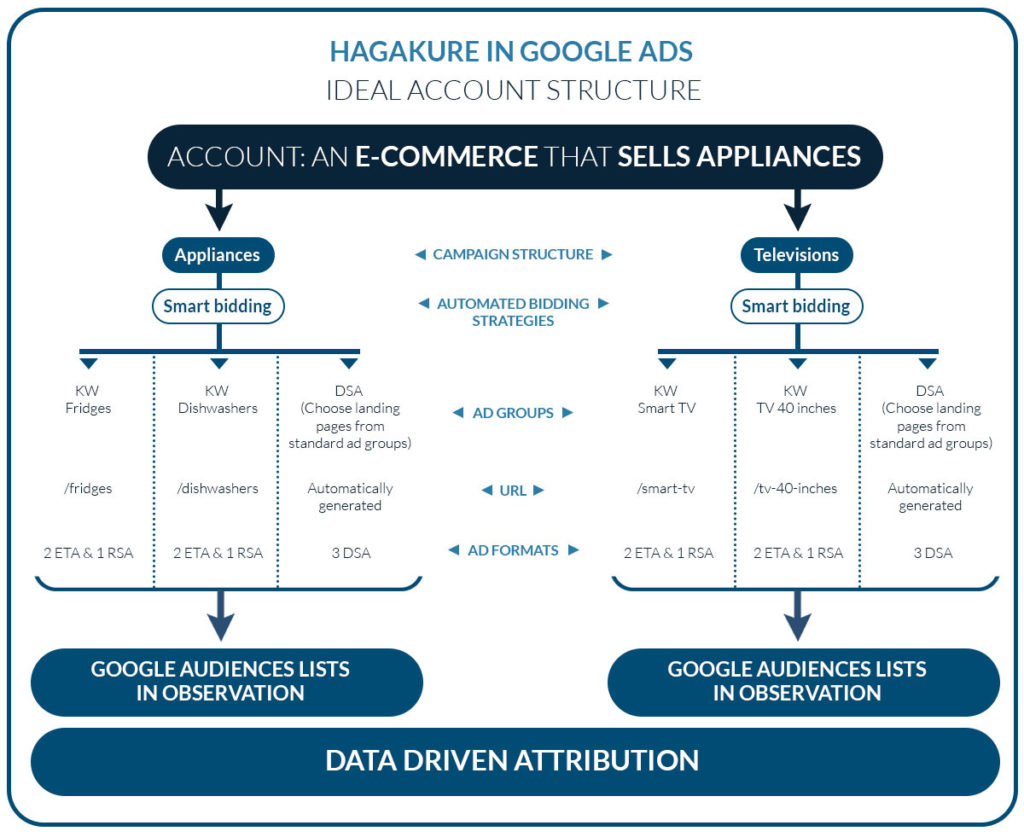The Hagakure method is a new way of structuring and optimizing campaigns on Google Ads in order to maximize results thanks to machine learning algorithms. The Hagakure system is based on the use of automated tools such as smart bidding strategies and dynamic search ads (DSA).
The term Hagakure has its origin in the Japanese tradition. It is the title of a piece that the samurai Yamamoto Tsunetomo wrote in the 18th century. In it, he explained to his apprentices the bushido or “warrior’s path,” the code of honor by which the samurai should be guided.
Moving this concept to the digital realm, Google suggests a new path for the management of Google Ads. Applying the Hagakure method means leaving behind atomization and semantics, opting instead for structural simplification to take advantage of all the potential of automatic learning.
The Hagakure method, a change of strategy (and mentality) in online search
The Hagakure method suggests simplifying the structure of the account to maximize the amount of data at the campaign level. In this way, each campaign consists of large groups of ads capable of collecting enough data to feed Google Ads’ machine learning algorithm.
Specifically, the minimum figure indicated by Google is 3,000 weekly impressions per ad group. To reach this volume and to be able to take advantage of smart bidding, Google recommends three steps:
1. Structure the account taking the destination URLs as reference instead of the keywords.
2. Prioritize types of matches such as broad or broadly modified that manage to attract more volume as opposed to others (exact) that are limiting.
3. Use the DSA to capture the searches that we are not covering with the rest of the ads hypothetically. You can set up a group of DSA ads for each type of product or one for all products.
Advantages of the Hagakure method on Google Ads
The Hagakure system allows to achieve more efficient accounts, given that:
- It facilitates reporting tasks and data interpretation by reducing account complexity.
- Results are improved without the need to increase the budget, thus optimizing the advertising investment and achieving greater profitability in the accounts.
- It increases the productivity of the team in charge of the account by focusing their efforts on strategic decision-making based on key KPIs for the business.
- Increased data recording enables faster learning from Google’s automated features (RSA, DSA and audiences).
How to apply the Hagakure method on Google Ads
Several phases can be identified:
1. Study in-depth the current account structure
It is essential to understand why the account has been designed in that way and to study the variables that explain it, such as the profit margin of each product, how geographic locations affect the business or which star products it works with, among others.
Let’s take an example. Formerly, the structure of an account for e-commerce of household appliances would be divided into a myriad of campaigns in the style of “branded refrigerators”, “generic refrigerators”, “branded dishwashers”, “generic TV”, “branded TV” and so on. With Hagakure, the restructuring of the account would be based on reducing the number of campaigns to operate under a broader search umbrella.
If this e-commerce has defined different profit margins for home appliances on one hand, and TVs on the other, that will be the criterion to use to reduce the number of campaigns and centralize them in this division. Then, within each one of them, it would be necessary to go to the historical data to detect which ad groups meet the premise of 3,000 weekly impressions. These can be maintained independently, while those with lower volumes should be grouped together.

2. Adapt the strategy of the new structure according to the business objectives
Setting the goal of each smart bidding campaign determines how it will understand the machine learning algorithm and the decisions it will make. The Hagakure method generally achieves very good results in campaigns with objectives linked to performance. To decide on one type or another, you have to take into account the main strategies that can be implemented with smart bidding:
- CPA campaigns: the algorithm follows the set CPA objective and aims to achieve the maximum number of conversions without exceeding it.
- Campaigns with ROAS objective: they seek to convert while complying with the ROAS objective, that is, the average conversion value that is expected to be obtained for each euro invested in ads. Without a doubt, this is one of the strategies that every account should be directed towards, given that it allows the alignment of business objectives (ROI) with those of advertising campaigns in Ads (ROAS).
- Campaigns aimed at maximizing conversions: they seek to achieve the highest number of conversions within a given budget.
- Campaigns to maximize conversion value: the algorithm obtains the highest value for each conversion within the assigned budget. In order to use this strategy, it is necessary to be recording the conversion value through the corresponding Google Ads measurement pixel.

It is important to plan this stage carefully and to define the objectives well. Once the smart bidding campaign is underway, the system needs about two weeks to learn and stabilize;therefore, during that time, you will likely see an uneven performance. During this period, which can sometimes be less than 15 days, we must be patient and let the algorithm operate: the optimization will come later.
Pilar Martínez, Senior Digital Marketing Consultant at Labelium Spain

3. Analyze performance and optimize
After the learning and testing phase, it is necessary to assess whether the objectives have been achieved, analyze if they were realistic and put them in the business context, taking into account factors linked to it such as seasonality or its own promotion schedule.
With Hagakure, optimization is a subtle task: the algorithm must be given time to interpret the changes made to the account and integrate them into its operation. For this reason, Google recommends making gradual adjustments within a 15% margin per week. For example, we are talking about avoiding going from a target ROAS of 4 to a target ROAS of 8 at once and the same goes for budget movements.
Pilar Martínez, Senior Digital Marketing Consultant at Labelium Spain
The Hagakure method and the power of machine learning
Over time, Google Ads accounts have gained in complexity by prioritizing the specificity and granularity of the structure. The Hagakure system represents a return to simplicity, but an intelligent simplicity supported by the most advanced machine learning technology.







